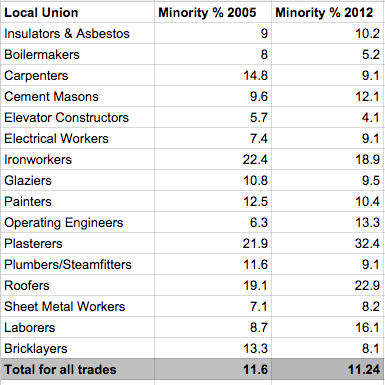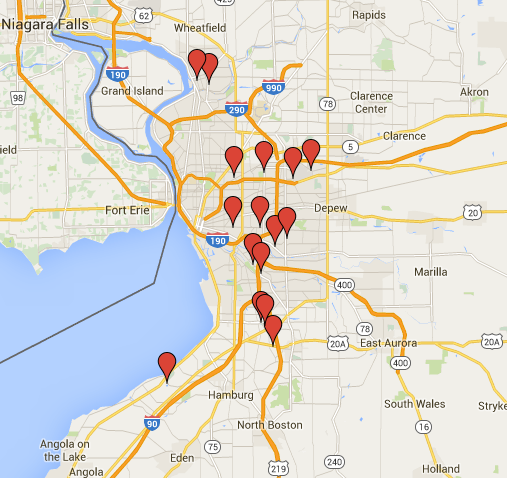Feb 23
2016
Buffalo trade unions lagging in diversity
Construction in Buffalo is booming. SolarCity. Children’s Hospital. The University at Buffalo Medical School. Taxpayer-funded projects like these are employing thousands of union construction workers.
But the boom has resurrected concerns that the unions have made little progress over the past decade in diversifying their membership.
While minorities make up 17 percent of Erie County’s workforce and more than half of the city’s population, they account for only 11 percent of unionized construction workers, according to the most recent figures available.
What’s more, there’s been virtually no change in the racial makeup of the building trades over the past decade, despite pledges to recruit more minorities as part of a $1.3 billion dollar program to rebuild city schools. Minority membership in the building trades increased by less than 1 percent between 2005 and 2012, according to figures compiled by developer LPCiminelli as part of the school renovations.
“These unions, they’re really resistant to change,” said Charley Fisher III, president of B.U.I.L.D Buffalo and co-founder of a new organization to monitor diversity in construction.
“There is not a fair representation of African-Americans and other minorities in the trade unions, period.”
The construction unions say they’re doing everything they can to increase diversity.
“We’ve spent thousands and thousands of dollars doing nothing but recruiting minorities,” said Paul Brown, president of the Buffalo Building Trades Council. “The biggest challenge is they don’t apply.”
—————————————————————————————————————
Listen to our radio version of this story broadcast on WBFO
—————————————————————————————————————
Investigative Post has spent the last two months interviewing 20 labor and community leaders and construction workers, and reviewing employment data and related documents, to determine why the construction trades haven’t made more progress in diversifying.
Union leaders say they have a problem finding minority applicants; community groups that offer training programs counter that they have more demand than they can accommodate.
There’s a profound disconnect between the two, a result of mutual mistrust and poor communication. As a result of this dysfunction, there’s no reliable pipeline for recruiting minorities into apprenticeship programs, the gateway to union membership.
The problem is compounded by structural barriers that make entry into the unions more difficult for people of color – in particular, the need for a driver’s license and a car, and the location of almost all union halls in the suburbs.
———————————————————————————————————
Jim Heaney discusses this story in an interview on The Capitol Pressroom
———————————————————————————————————
“It’s a question we need to ask: why are there opportunities in the trades that are going unfulfilled, and high minority – particularly male – unemployment here, and why we can’t marry those two things together?” said Kevin Schuler, vice president for corporate communications at LPCiminelli, the region’s largest construction contractor.
“If you can’t connect the trades and the community,” he said, “you end up where we’re at now: with pockets of people interested but no direct pipeline.”
History of failure
While leaders insist they’re doing their best to increase minority participation, statistics show that those efforts have not improved diversity to a significant degree.
The building trades in Western New York consist of 18 unions with a combined membership of about 7,000 – making them one of the region’s largest non-government employers.
In 2005, minorities accounted for 10.5 percent of union membership. That number inched up to 11.2 percent by 2012, the last year LPCiminelli did the census.
The state Department of Labor keeps more detailed records of unions’ racial makeup, but has so far refused to make those records available in response to a Freedom of Information request.
The problem of union diversity was supposed to have been solved years ago. One of the aims of the decade-long project to rebuild Buffalo schools was to boost minority participation in the unions and create a new generation of minority construction workers.
In 2003, the unions agreed to ambitious goals for recruiting a more diverse workforce. They pledged to reach 35 percent minority membership within the first five years of the project.
That didn’t happen.
A 2006 audit by the State Comptroller found that the recruitment goals could not possibly be reached, given the unions’ performance to that point. The audit also criticized the unions’ written plans to increase diversity for lacking specifics.
Brown, the Building Trades Council president, said the recession was largely to blame for the unions’ failure to meet the goal, as many took on fewer apprentices because there was less work.
There were other problems, as well.
A union-funded training center was closed down after a year of operation with $600,000 of debt – in large part because the start of new phases of the school construction kept being delayed. Only half of the program’s graduates said they stayed employed in the construction industry.
A similar program, which aims to prepare high school students to become apprentices, “works better than anything else we’ve done so far,” Brown said. “It’s the key to this whole thing.”
Graduates are guaranteed an apprentice slot – and 15 participants became apprentices when the program was offered in 2014, he said. Even so, the 15 would hardly make a dent in an overall membership of some 7,000.
The program has only been offered once in recent years, but Brown said Tuesday that it would be offered again starting March 29 at Burgard High School, with space for 25 students.
Assemblywoman Crystal Peoples-Stokes (D-Buffalo), who helped secure funding for the program in the state budget, said it could have been more effective if less sporadic.
“It’s a work in progress,” she said. “You can’t just do it once and expect that to change things; you have to do it consistently.”
Outreach and obstacles
Union outreach efforts are complicated by the fact that each of the 18 locals manages their own recruitment and has slightly different requirements for prospective apprentices.
Some require applicants to pass a math test or have a passing grade in high school algebra; others need candidates who aren’t afraid of heights. Some accept applications throughout the year; others only during a brief recruitment period.
Lack of transportation is another persistent problem. While people of color mostly live in the city, often relying on public transportation, almost all the unions halls are in the suburbs, and apprentices have to be able to travel to jobs sites across the region.
“Reliable transportation, a driver’s license, and showing up on time – those are three things that really knock people out of the box,” said Tracy Cardwell, public affairs manager at LPCiminelli, who recruited students for the pre-apprentice program.
Buffalo’s vocational schools, like McKinley High School, and some colleges, like SUNY Alfred, have links with some unions that guarantee spots for some of their students in apprentice programs.
Nonetheless, it’s a common complaint among union leaders that promising students – even at vocational schools – tend to be steered towards college rather than being encouraged to consider a career in the trades.
Chris Austin, a recruiter for the Carpenters’ Local 276, said 70 percent of high school students, regardless of race, fail his union’s math test, because they can’t add and subtract fractions or read a tape measure correctly.
“It doesn’t matter if they’re from Alleghany or Erie County – that’s just a problem with education as a whole,” Austin said.
Michael McNally, business agent for the Plumbers’ Local 22, said the biggest challenge in finding qualified minority applicants is “just getting the word out to the minority community to hand in applications for the apprentice program.”
“We have tried everything – TV ads, newspaper ads, ads on minority radio stations,” he said. “Our applications never increased.”
The opposite problem
There’s a stack of applications a foot high on the table in front of Spencer Gaskin.
He’s the founder of the OutSource Center, a construction training program on Fillmore Avenue on Buffalo’s East Side. The center offers five weeks of basic construction training and five weeks of math classes, resumé writing and personal development.
Applications keep piling up, even though the center isn’t currently offering any classes because of a lack of funding.
“I’m getting people in the community a job – that spreads like wildfire,” Gaskin said, adding that 70 percent of the center’s approximate 400 graduates have successfully found jobs in construction since the center’s founding nine years ago.
While the unions say they have a shortage of qualified minority candidates, many community groups offering construction training find themselves with the opposite problem, with more applicants than they have space for.
“If we ever got proper funding, we wouldn’t be able to handle the number of students coming in,” Gaskin said.
Washington, the PUSH Buffalo organizer, agrees.
“We don’t have a problem finding people, we have a problem finding work,” he said.
The OutSource Center’s students have worked on Rocco Termini’s renovations of the Hotel Lafayette and recently partnered with PUSH Buffalo to provide workers for Savarino Companies’ redevelopment of 500 Seneca Street near Larkinville.
Only nine of the center’s graduates have become union apprentices, however, of around 50 Gaskin estimates have applied. Many of the others work for non-union contractors, which pay less and offer fewer benefits.
“I think it’s a damn shame,” Gaskin said of the disconnect between his organization and the building trades. “All these young folks needing opportunity and the system is failing them.”
It’s a similar story at other community groups offering construction training.
It Takes A Village, in Amherst, offers classes in life skills and job readiness, as well as construction basics. But Executive Director Beverly Newkirk said only a handful of her graduates have become union apprentices, although more are in the process of applying.
“Their apprentice training has been very limited as far as allowing our people in,” she said.
“But, on our part, we have to be prepared to make sure people are ready to go into the unions. You know, they can’t be on drugs, and this has to be something they want.”
Disconnect, lack of trust
The unions have the opportunities – and a need for more workers. Community groups know where to find minority applicants who could benefit from those opportunities. But bridging the divide between the two sides has proven surprisingly difficult.
Union leaders tend to say: “They never call us.” Community leaders are equally likely to say: “They never call us.”
“They need to come to us, because we’ve tried to go to them,” said Brown, the president of the building trades council. “They all have my phone number and none of them have ever called me, so I would say they’re pretty much full of baloney.”
“These unions are not reaching out,” counters Gaskin of the OutSource Center. “They want to keep the status quo.”
There are complaints on both side about a lack of communication – and plenty of exasperation, with accusations of incompetence, on the one hand, and prejudice, on the other.
McNally, of the plumbers’ union, said: “We’re looking to put people to work. Should we be calling people or should they be calling us?”
Washington, the PUSH organizer, said the unions tend to exaggerate the difficulty of finding qualified minority applicants.
“What they aren’t always willing to admit is that plenty of people can do these jobs in Buffalo, there’s just a reluctance to let them in,” he said.
Schuler, the LPCiminelli vice president, said part of the reason for the disconnect is that while contractors, developers and unions all have a stake in increasing diversity in the construction workforce, “there is no one leading the charge every day whose sole focus is to address the issue.”
Goals provide incentive
Workforce diversity goals on publicly funded construction projects provide unions an incentive to diversity their ranks. The Building Trades Council came under fire after Investigative Post reported last fall that the diversity goal for the workers building the SolarCity factory at Riverbend had been lowered from the 25 percent originally proposed by the city to 15 percent, after union leaders and developer LPCiminelli said the higher number was unachievable.
The change was made, Brown said, because of the size of the job.
“If it’s a bigger job, the goal can’t be as high,” he said. “There’s just not enough of a workforce to do that.”
That’s exactly the problem, critics say.
A recent report from the Partnership for the Public Good found that racial disparities in employment are worse in Erie County than statewide and nationally.
Meanwhile, the amount of work has increased so fast that several unions have had to bring in several hundred workers from outside the region to keep up with the demand.
Others say that bringing in out of town workers means the Buffalo Billion money isn’t going where it’s needed.
“When it comes to state-subsidized projects, that money came here to solve the issue of poverty,” Washington said. “So, without a social focus, that money is really just subsidizing development.”
Assemblywoman Peoples-Stokes said the insular nature of the unions is another major obstacle to increasing diversity. They are still dominated by tight knit social and familial networks, she said, which can make it hard for outsiders to break in.
“And so,” she said, “if they’re really serious, then they should give people of color, men and women, the same opportunities that they give their nephews, their nieces and their sons.”



